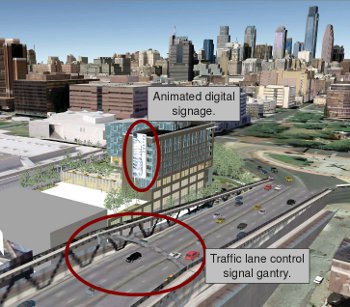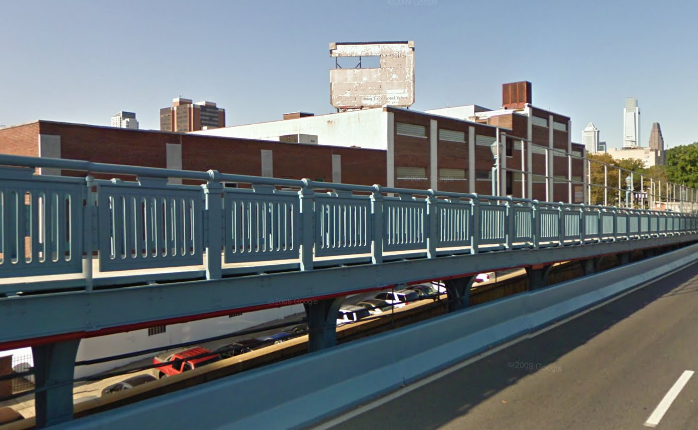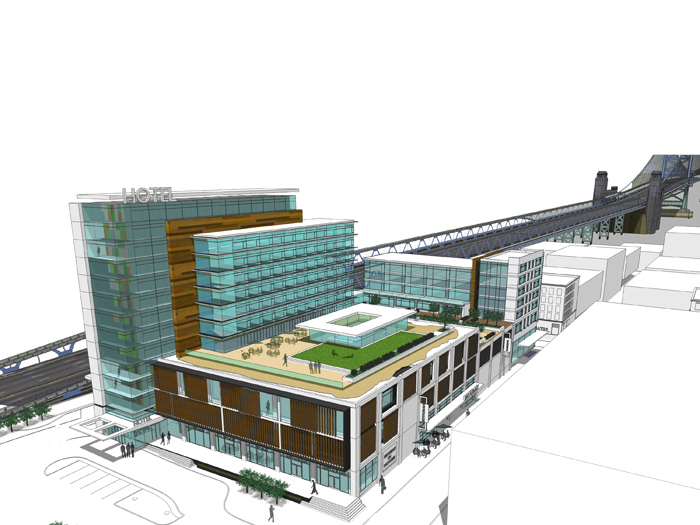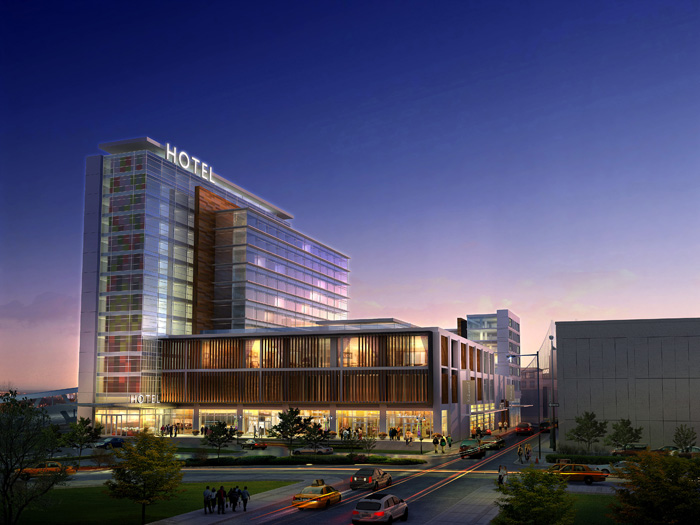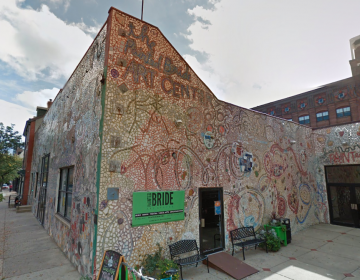Final vote on controversial Race Street hotel comes this week
City Council is set to vote Thursday on a zoning bill that would allow a hotel proposed for Old City to include a controversial electronic sign and live entertainment.
The bill had been on Council’s Dec. 9 calendar for final passage, but Council instead amended it, at the suggestion of its sponsor, First District Councilman Frank DiCicco. DiCicco aide Sean McMonagle said the change in wording replaces an earlier amendment, but has the same intent: It prevents the developer from building the proposed 35,000 square feet of retail and commercial space without the hotel.
The new wording was suggested by the city’s legal department, McMonagle said last week. The old wording “just wasn’t tight enough,” he said.
But Old City Civic Association Developments Committee Vice Chairman Joe Schiavo said the amendment doesn’t accomplish residents’ goal, because non-hotel businesses could still open in the 35,000 square foot space before the hotel is built.
“It doesn’t guarantee for the community that the hotel will ever get built before it opens the ground floor retail space,” he said.
Arc Properties CEO and founder Robert Ambrosi and his team have said that they would never want a nightclub or any other use that could potentially harm the hotel’s business, because the hotel is the main driver of the development.
This is precisely why Old City wants the bill to require the hotel to be substantially complete before anything can open in the retail space, Schiavo said.
“We’re being told the hotel is the regulator – if it is there, it won’t allow uses to occur on the floor below because it would be detrimental to the operation,” Schiavo said. “If the hotel is the great regulator, we need to know the hotel is going to be there before this place is open.”
After the meeting, DiCicco said the nightclub issue is one of misinformation or misunderstanding. He said he wouldn’t support any development that included a nightclub on that spot. As he sees it, a nightclub is a place dedicated to drinking and dancing, and this would be no such place, he said. “I’m told that under city code, Prime Rib is considered a nightclub. It isn’t. It’s a fine dining establishment with a piano player and sometimes a singer.”
The proposed project might include an eatery that has live music or a disc jockey, DiCicco said, adding that developer Ambrosi and Arc Properties want to bring in a Mexican themed place that has music and teaches customers to salsa.
Schiavo said he knows of no one in Old City who opposes the hotel or the hotel bar, hotel restaurant or hotel entertainment. Concerns are solely focused on what will happen in the 35,000 square feet that will be operated separately from the hotel, and on the sign, he said.
As far as the sign goes, DiCicco said he understands that some people oppose signage no matter what, but if this sign is necessary to the development, he’s willing to put up with it. Especially since the developer, who did not testify at council, has agreed to shield the billboard so it can only be seen from the Ben Franklin Bridge, and not to erect the sign until after a residential portion of the project is built between the sign and Old City residences.
“I think it is a much-needed project, not just for Old City, but for the whole city,” DiCicco said during the meeting. He elaborated afterward: The city needs about 2,000 more hotel rooms to make the expanded convention center successful. The 124 rooms of this hotel would be a start, he said. Due to poor economic conditions, it has been years since the city has built a new hotel, DiCicco said.
Because the final vote was postponed, many of the Old City residents who signed up to testify decided to save their testimony for next week’s council session.
Old City Civic Developments Committee sent each council member a letter recently, asking that the bill be amended so that it would change the underlying zoning of the parcel from industrial to commercial, allowing the building of the hotel, but not allowing the sign or the 35,000 square feet of commercial, retail and entertainment. These uses are not allowed under existing zoning rules for the area, including the Old City Overlay, and Old City Civic says the developer should have to go through the zoning variance process for this relief.
The Philadelphia City Planning Commission recommended that Council pass the bill, but only if the provision allowing for the sign was removed.
Schiavo said after the meeting that his organization will continue to try to persuade DiCicco to make changes to the proposed bill, including those listed in that letter.
Some opponents chose to testify even though the bill won’t be on the agenda until next week. Richard Remington, manager for governmental and public affairs for AAA Mid-Atlantic, testified that the sign should not be included in the development because it would lead to more accidents, just as texting or talking on a cell phone while driving do. “These electronic billboards are another form of distraction,” he said, and he urged City Council not to allow one on the hotel “in the interest of public safety.” AAA has been fighting these signs all around the country, he said.
SCRUB founder Mary Tracy, whose organization has fought billboards all over the city, held up a large photo of an electronic billboard in St. Louis that loomed large over a highway there. St. Louis’ city council is now fighting to prevent any more from coming to that city, she said. She praised Philadelphia’s city council for the legislative steps it has taken to reduce billboards in the city, and urged them not to pass the bill as written, because it would give relief from those measures.
“I strongly urge council not to change these laws to satisfy the demands of one developer,” she said.
Old City residents and developer Ambrosi actually see eye-to-eye on many elements of the proposal. They agree that the now-vacant former suit factory is a good spot for a hotel. They are pleased that Ambrosi changed the massing of the building, so that the side facing more residential areas is more in line with residential scale. And they like that he will reuse the existing structure on the site, building the hotel on top of it.
But the electronic sign and entertainment use have been huge issues in negotiations that have been going on for about two years.
Ambrosi and his team say while they originally proposed a billboard that would generate revenue for the project, they have abandoned that proposal for an electronic sign that will only give information about the hotel and other on-site uses. They say they will recess the sign into the building and surround it with shields that will make it visible only from the Ben Franklin Bridge. The sign is necessary, they say, because it will help brand the hotel and other on-site businesses and make them a destination.
But residents and other critics say regardless of what the sign advertises, it would still be a huge billboard that shines into some homes, distracts motorists traveling across the Ben Franklin Bridge, and detracts from the neighborhood aesthetic.
The other big sticking point is the up to 35,000 square feet of retail/commercial/entertainment space the new zoning change allows.
Ambrosi has said he is willing to stipulate in a community agreement, separate from the legislation, that no outside DJs would be allowed to rent the entertainment space, and that any music played would never be heard outside the walls of the building.
Residents also have said they are uncomfortable with Ambrosi’s team getting approvals before he can provide detailed information about the tenants in the 35,000 square foot lower level of the project, which would be run under separate management from the hotel.
They would love a supermarket and are fine with nice restaurants, but they don’t want fast-food places. Ambrosi said at a recent community meeting that he doesn’t want fast food, either. He said he would be willing to agree to no fast-food in the community agreement.
But Ambrosi said he can’t provide details on what businesses, exactly, would be located in the ground floor retail portion of the project, because he doesn’t have that nailed down yet.
The community wanted him to know before he got approvals; he said he couldn’t reach any agreements with tenants until the city approvals were in hand.
In other action, City Council also voted to create the Fox Chase Environmental Controls District, which prohibits commercial farming at Fox Chase Farm in Northeast Philadelphia. The planning commission voted against the bill, saying its provisions were redundant because the existing zoning already bars commercial farming at Fox Chase. The planning commission had made the same recommendation for the same reason when a similar overlay was proposed for Manatawna Farm in Roxborough. Council approved that one, too. Fairmount Park hoped to bring 10, half-acre urban farms to Manatawna. Planners said there is currently no plan to do anything similar at Fox Chase, but Fox Chase supporters were not convinced of that.
City Council was also visited by “Rocky” and serenaded by members of several unions that represent stage, radio and television actors and other performers. The song was written to thank council for a resolution urging businesses that employ talent to work with the unions. Watch the video below:
Reach the reporter at kgates@planphilly.com.
WHYY is your source for fact-based, in-depth journalism and information. As a nonprofit organization, we rely on financial support from readers like you. Please give today.



